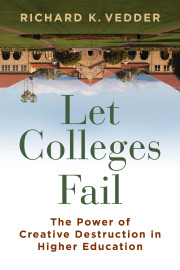The National Center for Education Statistics reports that 99 postsecondary schools shut down this past academic year, roughly two per week. What the great economist Joseph Schumpeter called “creative destruction” is finally coming to higher education.
Creative destruction was critical to the United States becoming the largest economy on Earth. Companies failing to adjust to changing consumer tastes, prices, and technologies were severely punished, while nimble, prescient entrepreneurs became wealthy. Once prominent companies such as Eastman Kodak, for example, went either bankrupt or became small shadows of their former selves, which freed resources to fund emerging new business leaders.
Universities, however, have largely been insulated from this productive chaos by government subsidies and private philanthropy.
While the “bottom line” in higher education is much harder to define than in business with its changing market valuations and earnings reports, it is clearly in trouble: 2023 enrollments were about 15% less than in 2011, and polling shows public support for universities has plummeted. Moreover, inflation, along with aggressive tuition discounting, means that tuition fees have fallen noticeably in real terms. When demand falls while supply remains nearly unchanged, both prices (tuition fees) and quantities (enrollments) fall, squeezing tuition-dependent schools substantially.
Why is this happening? There are two big differences between the business world and higher education that relate to incentives and control (ownership).
First, while businesses have huge incentives to become more productive by cutting costs and offering new, better goods to customers, those pressures are largely absent in the academy. During the pandemic, for example, the federal government provided universities billions of dollars in extraordinary assistance. Highly productive professors rarely get big rewards. Successful college football coaches, operating more in a market environment, sometimes make five times as much as their university president.
Second, markets and property rights dictate that Elon Musk will make key decisions about X and SpaceX, both of which he owns. Moreover, no one questioned the right of the board of directors of Starbucks to replace its CEO recently with the highly successful Chipotle head, as Starbucks’s record of long rapid and highly profitable growth stalled. This happens far less often in universities.
Indeed, who even runs the universities? The president? The faculty? Wealthy alums? Donors? Students? All claim a role. And the legal governing board is often clueless, wined and dined by the president but given little role to play except selecting a new president every few years. As one trustee friend told me, “We are potted plants.”
Limited incentives and ambiguous ownership have brought vast inefficiencies to universities, which operate at full capacity only perhaps eight months out of the year with bloated administrations. These problems have also led to an increasingly hard-left political culture intolerant of civil debate and intellectual diversity necessary for a vibrant learning community.
The solution? Let creative destruction do its job with the universities. As more schools fail, out of desperation, needed changes will happen.
There are five promising developments in this regard. Increasingly active governing boards are adopting institutional neutrality policies stating the university will generally not take positions on issues of public policy, although individual faculty will be free to express themselves civilly as long as they don’t interfere with the rights of others.
Ultra-“woke” presidents are increasingly losing their jobs. The most recent example is the leftish president of Colorado College, L. Song Richardson, who resigned because she couldn’t accept the governing board’s call for institutional neutrality by keeping quiet on controversial political issues.
In several state universities, new autonomous centers with a conservative/traditionalist orientation have been established by legislatures or governors, giving students alternatives to the dominant progressive agenda. States such as Florida, Texas, Arizona, Tennessee, and North Carolina have created robust semi-independent centers. Ohio created such centers at five schools.
Diversity, equity, and inclusion, or DEI, centers responsible for much of the progressive activism on campuses and mandated diversity commitments are being closed or downgraded in several schools, partly in response to the Supreme Court Students for Fair Admissions v. Harvard decision.
And lastly, schools with perceived strong antisemitic sympathies are facing sharp application and donation declines, while some conservative, traditionalist schools are booming, including religiously oriented institutions. Unless the Democrats take complete control of the federal government this fall, prospects for federal bailouts saving faltering schools are dismal.
Policymakers can continue these positive trends by embracing two market-based ideas to hold higher education accountable. First, give state funding not to universities but to students through vouchers or scholarships. Let consumers control public tuition money, making producers compete for it.
And second, privatize federal student loan programs, encouraging Income Share Agreements where students sell equity in themselves (a percent of postgraduate earnings for a number of years) to private investors in return for financial support. This would get the federal government out of the disastrously inefficient and costly student loan business.
These reforms would go a long way toward getting higher education back on track.













